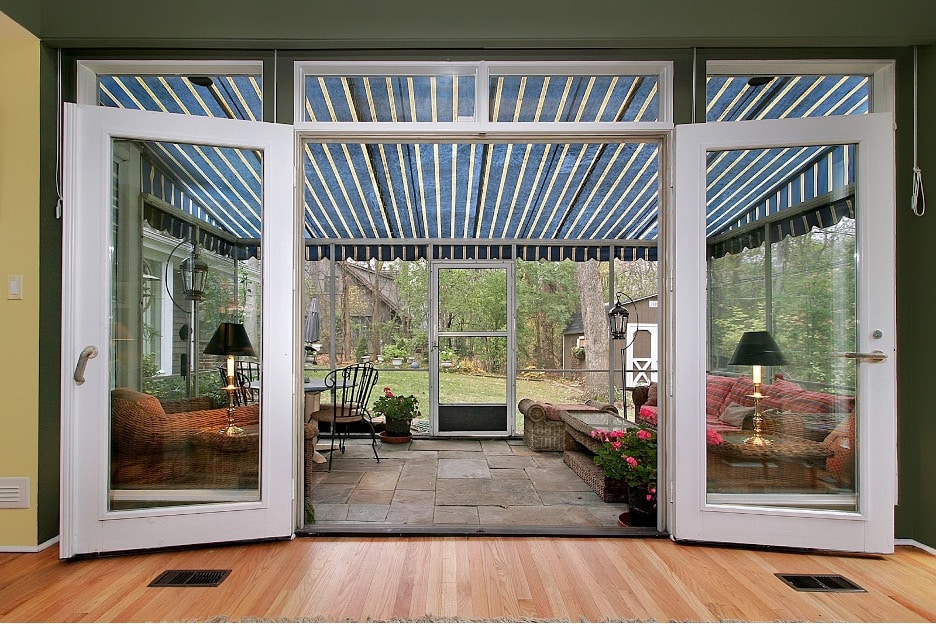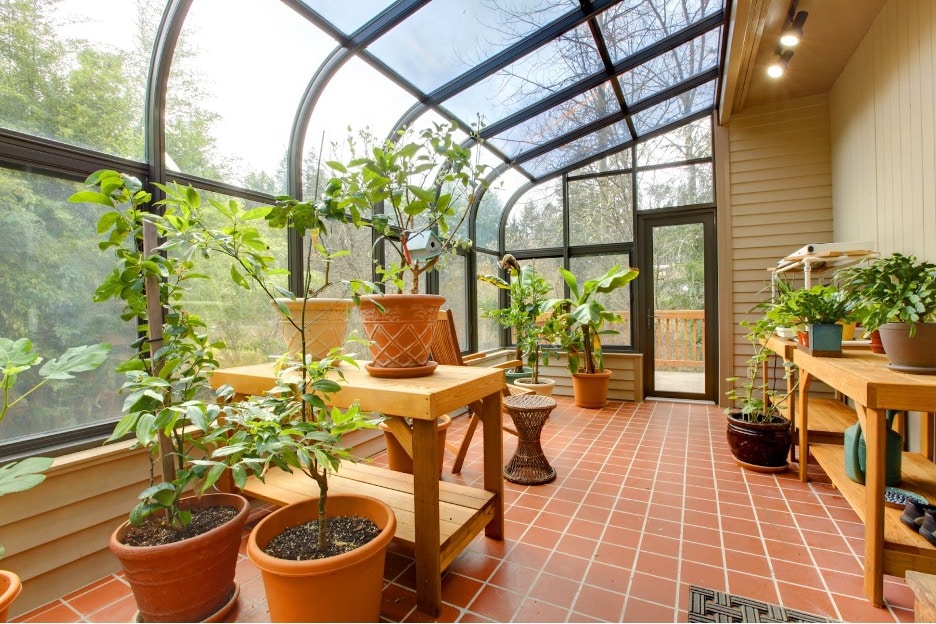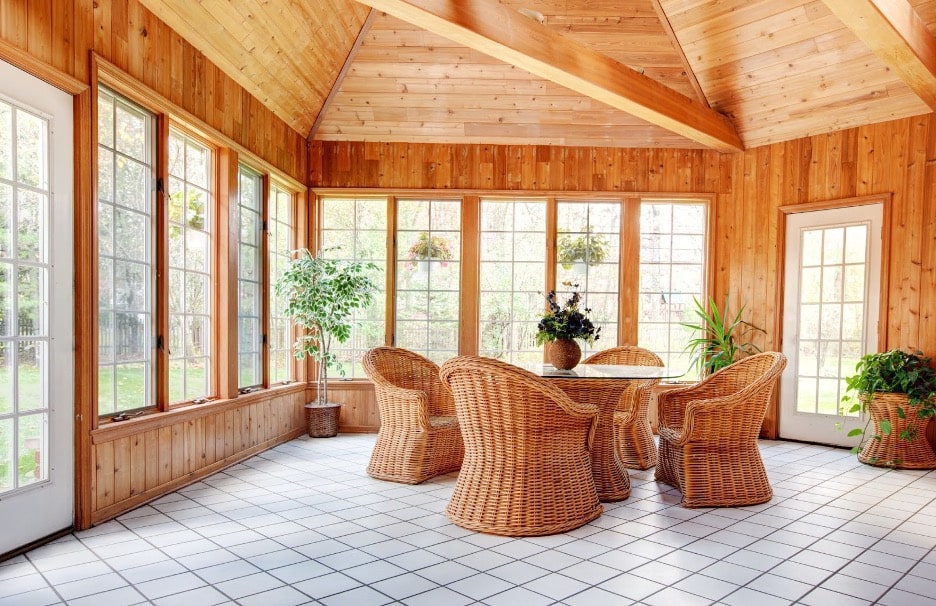
Sunrooms are a popular home improvement project among homeowners. A sunroom is a space that is designed to allow natural sunlight to enter while providing protection from the elements. Sunrooms are often used as a space for relaxation and entertainment or as an extension of the living area.
A sunroom can be attached to your home or built as a standalone structure and is designed to provide a comfortable and enjoyable space that can be used year-round. They are a popular addition to homes as they allow homeowners to enjoy the beauty of nature without being exposed to the weather, insects, or other outdoor nuisances. They are also a great way to add extra living space to a home and can help to increase the value of your property.
Types of Sunrooms
When it comes to sunrooms, there are several kinds to choose from. Each type provides slightly different benefits and the costs can vary.
Three-Season Sunroom
Three-season sunrooms are typically designed for use in milder seasons such as spring, summer, and fall. They are not usually heated or insulated, which means that they may not be suitable for use in colder weather. However, they can be a cost-effective way to add extra living space to a home, as they often require less insulation and heating than some other types of sunrooms.
Three-season sunrooms can be designed with large windows or screens that allow plenty of natural light and ventilation to enter the space. This makes them a great option for homeowners who want to enjoy the beauty of nature while still being protected from insects and the elements.
Four-Season Sunroom
Four-season sunrooms are designed to be used year-round, regardless of the weather conditions outside. They are mainly constructed with insulated walls, floors, and roofs, and often have heating and cooling systems installed to ensure that they remain comfortable throughout the year.
Four-season sunrooms offer more versatility in terms of how they can be used, since they can function as an extension of the home’s living space, a dining area, a home office, a playroom for children, and so much more. However, they can be more expensive to build and maintain than three-season sunrooms due to the additional insulation and climate control systems required. Homeowners who live in regions with harsh winters or hot summers may benefit from investing in a four-season sunroom to enjoy the benefits of natural sunlight year-round.

Screened-In Sunroom
Screened-in porches are a type of sunroom designed to provide protection while still allowing for plenty of natural light and fresh air. They are usually constructed with screens around the walls and ceiling, which allows homeowners to enjoy the beauty of nature completely.
Screened-in porches are often less expensive than other types of sunrooms because they do not require as much insulation or climate control systems. However, they may not offer the same level of protection from the elements as other sunrooms. Screened-in sunrooms are a popular addition to homes in areas with mild climates, as they provide a comfortable outdoor space that can be used for relaxation, dining, or entertaining.
Solarium
Solariums are a type of sunroom that is designed to maximize the amount of natural light that enters the space. They are often referred to as “sun porches” or “sun lounges,” and are typically constructed with walls and roofs made entirely of glass or other transparent materials. The purpose of a solarium is to allow homeowners to enjoy the beauty of the outdoors while still being protected from the elements.
Solariums can be a great addition to homes that have limited access to natural light, as they can help to brighten up a space and create a more open and airy feeling. They are also ideal for homeowners who love to grow plants, as they provide the perfect environment for indoor gardening. However, it’s important to note that solariums can be more expensive to build and maintain than other types of sunrooms due to the large amount of glass and other materials required.

The Benefits of Adding a Sunroom to Your Home
Adding a sunroom to your home can provide a number of benefits. Depending on your lifestyle, relaxation preferences, and climate, a sunroom may be just the right improvement for your home.
Additional Living Space
Sunrooms can provide a comfortable and enjoyable space for a variety of purposes, from relaxation to entertaining and recreation. By adding a sunroom to your home, you can create additional living space that can be used for a variety of activities, including reading, lounging, dining, or even as a home office. This additional space can enhance your quality of life by providing a peaceful and relaxing environment where you can unwind and enjoy the beauty of nature without leaving the comfort of your home.
Enjoy the Benefits of Nature
Sunrooms provide a unique way to enjoy the beauty of nature without actually being outside in the heat or cold. By adding a sunroom to your home, you can enjoy the beauty of the outdoors in a comfortable and controlled environment.
Sunrooms are designed with large windows that provide ample natural light and offer stunning views of your surrounding landscape. You can also add features such as retractable screens or ceiling fans to keep the space comfortable and inviting. With a sunroom, you can relax and unwind in a serene and peaceful environment, all while enjoying the beauty of nature from the comfort of your home.

Health Benefits
Exposure to natural light and fresh air has been shown to have a positive impact on both physical and mental health. Sunrooms are designed to allow plenty of natural light to enter your home, which can help regulate your body’s natural sleep-wake cycle and promote healthy vitamin D levels. Additionally, sunrooms can provide access to fresh air, which can help reduce indoor air pollution and improve respiratory health.
Sunrooms can also help to reduce stress and anxiety by providing a peaceful and calming environment where you can relax and unwind. The benefits of natural light and fresh air are well-documented, and adding a sunroom to your home can be a great way to promote overall health and well-being for you and your family.
Increase Home Value
Adding a sunroom to your home can increase its value, which can be beneficial if you plan to sell your home in the future. Sunrooms are a desirable feature for many homebuyers, as they provide additional living space and a unique way to enjoy the beauty of nature from the comfort of your home.
By adding a sunroom to your home, you can increase its overall value and appeal to potential buyers, which can help you to sell your home more quickly and at a higher price. Additionally, adding a sunroom to your home is a great addition that can provide a return on investment both in terms of increased home value and the enjoyment you’ll get from using the space while you’re still living in your home.
HFS Can Help You Finance Your Sunroom Project
Financing your sunroom project is hassle-free with help from HFS Financial. With our expertise in personal loan options, you can get direct-to-consumer funding with no down payment required.
HFS makes it easy by putting you, the homeowner, in control of your finances. Once you’ve qualified for your loan, you will receive the money directly so that you can pay your contractor on your agreed-upon schedule. This avoids the potential for delayed payments, lengthy inspections, and frustrated contractors.
Getting started with a loan through HFS is simple. Begin by filling out our 60-second inquiry form to help determine your qualification status. After completion, one of our exceptional loan consultants will reach out to you to help you finalize your application upon pre-qualification.
The next step is to securely upload some basic documents to confirm the information you provided. Once the required documents are received, there is generally not much left for you to do other than relax and make final plans for your sunroom project.
At HFS Financial, “You Dream It, We Finance It.” Get started with our Check Your Rate form today, and you’ll be relaxing in your sunroom in no time. If you have any questions along the way, you can always contact us. We are here to help!
